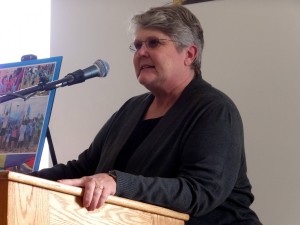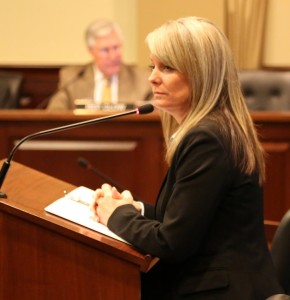Now that school administrators have scores from Idaho’s new statewide assessment, their job is to make use of the numbers.
And that’s complicated, for a couple of reasons. First, this newest version of the Idaho Standards Achievement Test bears little similarity to the namesake that preceded it. Second, this year’s test results were delayed, and districts didn’t get the numbers until summer break.
So in the Kimberly School District, for instance, no one’s had much of a chance to dive into the results, which generally came in ahead of state averages. The district’s leadership team is just getting back to work, and teachers aren’t back yet. Consequently, Superintendent Luke Schroeder doesn’t have any specific plans for changing curriculum or teacher training in response to the results.
“We’ll be diving into that as the year begins,” he said.
The test results are a topic of conversation at the Idaho Association of School Administrators’ annual conference in Boise this week. The message from the State Department of Education was encouraging, as it was in July, when the department first released statewide results. In the first year of the test — better known as SBAC, for the multistate Smarter Balanced Assessment Consortium that developed it — Idaho students beat projections. Roughly half of the student scores came in as proficient or better.
“We’re obviously doing something right,” Nancy Thomas-Price, the department’s comprehensive assessment coordinator, told a room full of local administrators Wednesday.
While Thomas-Price was impressed with the first-year numbers, the results were hardly uniform. Scores on the English language arts portion of the test ran higher than the math scores — a pattern replicated in districts across the state, Thomas-Price said. ELA scores improved in the upper grades while math scores dropped; 61 percent of 10th graders scored proficient or better in ELA, while only 30 percent met the benchmark in math.
While the statewide scores detail the big-picture patterns, district scores can be much more volatile. Earlier this week, Thomas-Price said she talked to an official from a smaller district, flummoxed by a 20 percent drop in one grade’s scores. In a small district, one teacher can have a big effect on scores districtwide. And as Thomas-Price notes, all teachers are adjusting to a test that is not only aligned to the new Idaho Core Standards, but moves away from a conventional multiple-choice testing format.

For Melba district Superintendent Andrew Grover, the test scores provide an important benchmark — although some results were “disheartening.” The Canyon County district met or exceeded its own 40 percent proficiency goals in ELA, but after three years of preparation for Common Core, Melba’s math scores fizzled in the upper grades. Only 18 percent of ninth- and 10th-graders scored proficient or better. “We’ll get back to work in a couple of weeks,” he said.
The challenge, though, comes in figuring out what to change as a result of this spring’s SBAC scores.
In the West Ada School District, SBAC scores beat state averages across the board, often by double-digit margins. Superintendent Linda Clark said she was “fairly pleased” with the numbers, which reflected an effort to frontload Common Core preparation, especially in math.

Still, she cautions that this year’s SBAC scores represent only a one-time baseline. The most powerful test results — and the results teachers want — measure student growth. West Ada will move its Measures of Academic Progress, or MAP, test to the fall to avoid the busy spring testing window. But while MAP will provide West Ada teachers with a measure of student growth from one fall to the next, this won’t provide teachers with a yardstick for growth from the start of the academic year to the finish.
Will the SBAC fill this void?
In theory, it is supposed to. The test is supposed to include a component to measure student growth — but, said Clark, that element hasn’t been built in yet.
Whether the SBAC evolves might depend on whether the SBAC survives political and stakeholder scrutiny.
Angela Hemingway — the State Department of Education’s assessment and accountability director — told school administrators this week that she “worked very hard” to secure a three-year contract for the SBAC. The goal was to build some stability into the process.
Hemingway, who is leaving later this month to head Gov. Butch Otter’s STEM action center, knows that some superintendents want to see the three-year process through. Others, she concedes, are ready to dump the test after one year.

That first year was rocky, and provides some additional fodder for critics who were already skeptical about the test. Results were delayed, well past the May 22 end of the testing window. That has left districts scrambling to figure out how to get the results to parents — and how to apply the results in the classroom.
The first round of the SBAC reinforced some lingering concerns about the test — in particular, worries that the online assessment takes too much time and gobbles up too much computer lab access.
“Once kids finish the test, it is challenging to provide instruction,” said Chad Williams, superintendent and high school principal in the Ririe School District. “We are on a trimester schedule and have added five days to the third trimester to accommodate testing. I am not convinced the data we receive from the ISAT is worth five days of instruction from teachers.”
Take a look at the results
The State Department of Education will not release district-by-district SBAC scores until October, although districts have their results. This week, Idaho Education News asked districts and charter schools to send in their scores; you can download what we have here.
The grade-by-grade numbers reflect the percentages of students who scored proficient or better on the English language arts and math assessments. We will update this spreadsheet as more scores become available.
